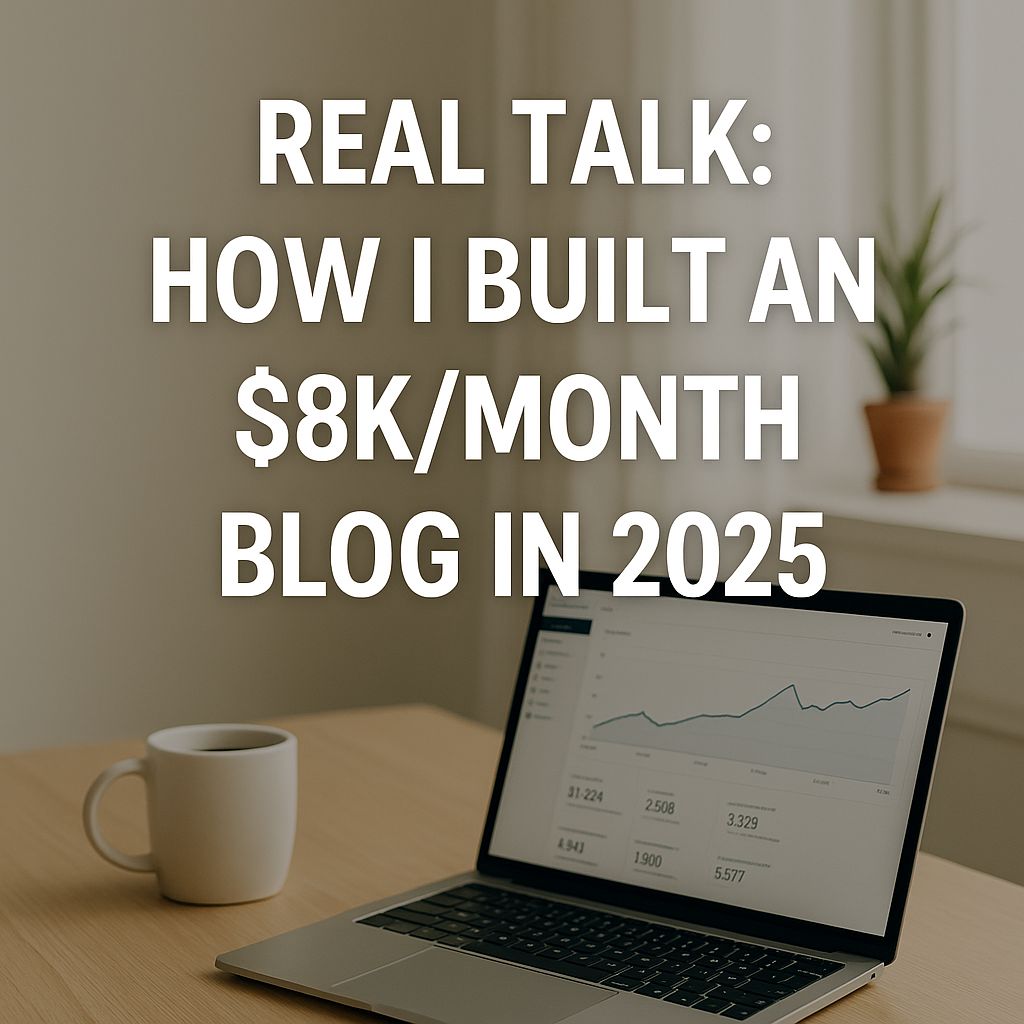Look, I’m gonna be honest with you. When I started my blog three years ago, I had zero clue what I was doing. I’d just gotten laid off from my marketing job, had $800 in my bank account, and was desperately googling “how to make money online” at 2 AM.
Fast forward to today? Last month I made $8,247 from my blog. Not bragging – just want you to know this stuff actually works if you stick with it.
Here’s the thing though: most blogging advice out there is either outdated or written by people who’ve never actually done it. I’m writing this because I wish someone had given me the real, no-BS version when I started.
Why Blogging Still Works (Despite What People Say)
Everyone keeps saying blogging is dead. These are usually the same people posting 47 TikToks a day hoping to go viral.
Here’s what they don’t get: while everyone’s chasing the latest social media trend, blogs are quietly making bank. My friend Sarah makes $12K/month from her parenting blog. My neighbor Dave? $4K monthly writing about woodworking.
The difference is ownership. When Instagram changes their algorithm (again), your reach tanks overnight. When you own a blog, you control everything. Your audience, your content, your income streams.
Plus, people are actually craving longer, thoughtful content now. TikTok burns out your brain after a while. Sometimes you want to actually learn something useful.
Finding Your Thing (Without Overthinking It)
My biggest mistake? Starting a “lifestyle blog” because I thought it would appeal to everyone. Spoiler alert: it appealed to no one.
Success came when I got specific. Instead of writing about everything, I focused on productivity tips for people working from home. Suddenly, my content had direction.
Here’s my simple test: Can you think of 25 blog post ideas right now without googling anything? If yes, you’ve found your niche. If you’re struggling to hit 10, pick something else.
What’s working right now:
- AI and productivity tools (everyone’s trying to figure this stuff out)
- Personal finance for specific groups (millennials, freelancers, new parents)
- Remote work tips (not going anywhere anytime soon)
- Specific health niches (not general wellness – think “meal prep for shift workers”)
Don’t pick something because it “makes money.” Pick something you actually find interesting. Trust me, you’ll be writing about it A LOT.
Getting Your Blog Live (The Boring But Necessary Stuff)
Okay, technical setup time. Don’t panic – it’s way easier than it used to be.
Your blog name: Keep it simple. Mine is ProductivityWithPurpose.com. Not winning any creativity awards, but it works. Avoid anything with numbers, hyphens, or words your mom can’t spell.
Hosting: I use SiteGround ($7/month) because it’s fast and their support actually helps when things break. Bluehost is cheaper ($4/month) and fine for starting out. Both install WordPress automatically, so you don’t need to be a tech genius.
Theme: Don’t spend weeks picking the perfect theme. I use Astra because it loads fast and doesn’t look like every other blog. GeneratePress is another solid choice.
Must-have plugins:
- RankMath for SEO (free version is plenty)
- WPForms for contact forms
- UpdraftPlus for backups (learned this the hard way)
Essential pages:
- About page (tell your story – people connect with humans, not brands)
- Contact page
- Privacy policy (boring but legally required)
I spent three months tweaking my design before publishing anything. Don’t be me. Get it “good enough” and start writing.
Writing Stuff People Actually Want to Read
Content creation was terrifying at first. I’d stare at the blank screen for hours, then write something terrible and delete it.
Here’s what finally clicked: stop trying to sound like a “professional blogger.” Write like you’re explaining something to a friend over coffee.
My process now:
- Monday: Brainstorm ideas (I keep a running list on my phone)
- Tuesday: Research and outline
- Wednesday: Write first draft (no editing, just get it out)
- Thursday: Edit and optimize for SEO
- Friday: Publish and promote
Post types that consistently perform:
- Step-by-step tutorials (“How I organized my entire life using Notion”)
- Tool reviews (honest opinions, not sales pitches)
- Personal stories with lessons (“What I learned from my biggest productivity failure”)
- Resource roundups (“15 apps that actually save me time”)
My writing formula: Start with a hook (story, question, or bold statement), promise what they’ll learn, deliver the goods with specific examples, then tell them what to do next. That’s it.
Length? Long enough to be helpful, short enough to stay interesting. Usually 1,500-2,500 words for me.
Getting Google to Actually Find You
SEO sounds scary but it’s really just about being helpful and organized.
I use Ubersuggest (free version) to find keywords. Instead of going after “productivity tips” (impossible to rank for), I target stuff like “productivity apps for ADHD” or “time blocking for freelancers.”
My SEO checklist:
- Put my main keyword in the title and first paragraph (naturally, not stuffed in)
- Use headers (H2, H3) to break up content
- Add alt text to images
- Link to other posts on my blog
- Write a decent meta description
The secret sauce? Write for humans first, search engines second. Google’s gotten really good at spotting content written just for SEO. They hate it, and so do readers.
Getting Eyeballs on Your Blog
Publishing great content is only half the battle. You gotta get it in front of people.
Pinterest has been my secret weapon. I create 3-4 pins for each post using Canva, and some of them take off like crazy. My “morning routine” post got 50K views from one pin. Pinterest is basically Google for lifestyle content.
Email list is everything. I wish I’d started this sooner. When social media algorithms change, your email list doesn’t care. I use ConvertKit and have about 8,000 subscribers who generate most of my income.
How I grow my list: free resources. Checklists, templates, mini-courses. People love free stuff that actually helps them.
Social media strategy:
- LinkedIn for professional content (my audience hangs out there)
- YouTube for tutorials (repurpose blog content into videos)
- Twitter for quick tips and connecting with other creators
Guest posting: Write for other blogs in your space. It’s free marketing and builds your authority.
The Money Part (Why We’re Really Here)
Let’s talk numbers. Last month’s breakdown:
- Affiliate marketing: $3,200
- Digital products: $2,800
- Coaching: $1,500
- Sponsored posts: $747
Affiliate marketing: I only promote stuff I actually use. ConvertKit, Canva Pro, online courses that helped me. Commission rates vary, but I average about $50 per sale.
Digital products: Started with a $19 productivity planner (made in Canva). Now I sell courses, templates, and coaching programs. Highest profit margin because you create once, sell forever.
Coaching: One-on-one blog consultations at $200/hour. People pay for personalized advice and accountability.
Sponsored posts: Brands pay me to write about their products. Usually $300-800 per post depending on my traffic that month.
I didn’t make a penny for the first four months. Month five, I earned $73 from affiliate marketing. Month twelve, I hit $2,000. Growth isn’t linear – some months suck, others surprise you.
Tracking What Actually Matters
I check these numbers weekly:
- Organic search traffic (most important)
- Email subscribers
- Revenue per post (which content actually makes money)
- Top exit pages (where people leave my site)
Tools I actually use:
- Google Analytics (free, tells you everything)
- ConvertKit (email stats)
- RankMath (SEO tracking)
Don’t get lost in vanity metrics. Page views are nice, but email subscribers and revenue matter more.
Mistakes That Cost Me Money
Waiting too long to start email marketing. I was eight months in before I added an email signup. Those early readers are gone forever.
Trying to write for everyone. My early posts were generic because I didn’t want to exclude anyone. Turns out, when you write for everyone, you write for no one.
Inconsistent publishing. I’d post five articles in a week, then nothing for a month. Google and readers prefer consistency over bursts.
Perfectionism paralysis. I rewrote my About page 47 times. Nobody cared as much as I thought they would.
Ignoring Pinterest. I thought it was just for recipes and wedding planning. It’s actually a traffic goldmine for most niches.
Your First 90 Days (Real Timeline)
Month 1: Get your blog set up and publish your first 8-10 posts. Focus on quality over quantity. Set up Google Analytics and start an email list (even if nobody signs up yet).
Month 2: Keep publishing consistently. Create your first lead magnet (free resource). Start pinning on Pinterest. Join Facebook groups in your niche and actually participate (don’t just promote yourself).
Month 3: Apply to affiliate programs. Start reaching out for guest posting opportunities. Create your first digital product (can be simple). Double down on what’s working.
Realistic expectations:
- Months 1-3: Maybe 100 visitors per month, zero income
- Months 4-6: 1,000-5,000 monthly visitors, first affiliate sales
- Months 7-12: 10,000+ monthly visitors, $500-2,000 income
Don’t quit your day job immediately. Treat this as a side hustle until it consistently pays your bills.
Just Start Already
Here’s the truth: you’re never gonna feel ready. I didn’t feel ready when I started. I still don’t feel ready half the time.
But here’s what I know after three years: the biggest difference between successful bloggers and wannabes isn’t talent or luck. It’s showing up consistently, even when you don’t feel like it.
Your first post will probably suck. Mine did. Your tenth post will be better. Your hundredth post might even be good.
The internet doesn’t need another perfect blogger. It needs your perspective, your experiences, your way of explaining things.
Start today:
- Pick your niche (don’t overthink it)
- Buy your domain
- Set up hosting
- Write your first post
- Publish it (even if it’s not perfect)
The hardest part isn’t the technical stuff or learning SEO. It’s publishing that first post and admitting to the world that you have something to say.
But once you do, everything else gets easier. And who knows? A year from now, you might be writing your own “how I make money blogging” post.
Your future self is counting on you to start today.
Questions about blogging? I read every email and often turn reader questions into future posts. Hit me up – I remember what it’s like to be completely lost at the beginning.
Frequently Asked Questions (FAQs)
1. How long does it take to start earning from a blog?
Answer:
It really depends on your niche, effort, and consistency. On average, it can take anywhere from 3 to 6 months to make your first $100, and around a year to start seeing regular income. The key is to focus on building trust and delivering value through every post.
2. Do I need to be a tech expert to start a blog?
Answer:
Not at all. With platforms like WordPress and beginner-friendly hosting services, you can launch your blog without writing a single line of code. Most tools now offer drag-and-drop features and tutorials to guide you step-by-step.
3. Can I still start a blog in 2025 and make money?
Answer:
Absolutely. Blogging is far from dead — it has simply evolved. If you’re willing to focus on a specific niche, produce helpful content, and understand SEO basics, there’s plenty of opportunity to grow a profitable blog in 2025 and beyond.
4. What’s the best way to get traffic to a new blog?
Answer:
In the beginning, focus on SEO and Pinterest. These platforms offer long-term, sustainable traffic. Later, you can expand to YouTube, email marketing, and collaborations with other creators to multiply your reach.
Conclusion
Starting a blog in 2025 might feel overwhelming — and trust me, I get it. When I launched mine, I had zero clue what I was doing. But little by little, post by post, I built something that not only earns money but brings freedom and purpose.
The biggest lesson I’ve learned? You don’t need to be an expert to get started. You just need to show up, stay consistent, and keep learning. Whether you’re starting with $800 in the bank like I did, or just a notebook full of ideas, you’ve got everything you need to begin.
So don’t wait for the “perfect” time. Hit publish. Share your story. Someone out there is searching for exactly what you have to say.





